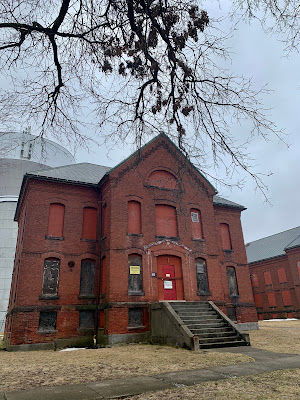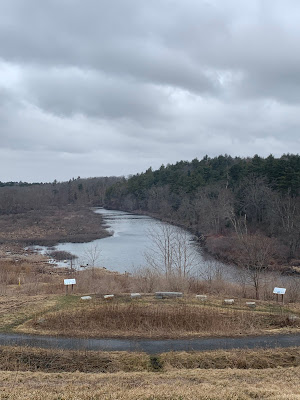A few weeks ago Tony and I visited Medfield State Hospital, in charming Medfield, Massachusetts. Originally known as the Medfield Insane Asylum, the hospital is now a park open to the public. Intrigued? Read on.
Medfield State Hospital opened in 1896, and was one of the state's first hospitals to deal with long-term patients with mental disorders. It was designed in the "cottage style," according to an informational sign erected at the hospital, with more than 50 buildings spread across 1.4 square miles. Many of the buildings are still standing, although they are now boarded up and public cannot access them. Medfield State today looks a lot like a small, traditional New England liberal arts college - but with absolutely no people. It's both charming and maybe a little spooky.
Tony and I visited on a cold, snowy day, and there weren't many other visitors. A few people were walking their dogs, but that was about it. The hospital was quite bustling in the past, however. During World War II, almost 2,300 people lived at Medfield State. The hospital finally closed in 1993.
In the early part of the 20th century, the hospital was self-sufficient. Patients grew crops on hundreds of acres of farmland, and tended more than 1,000 cattle and 3,000 chickens. That's quite an operation! Medfield State Hospital even was able to supply food to the other state hospitals in eastern Massachusetts. Even today there is still quite a bit of open land at Medfield State, including a bluff overlooking the Charles River. It has a great view!
You'd think there would be some weird legends associated with an abandoned insane asylum, but that's not really the case here. The only possible ghost story is quite recent. In 2017, the movie The New Mutants was filmed at Medfield State. Part of the X-Men series, The New Mutants tells the tale of five young mutants imprisoned in a spooky hospital. The movie wasn't released until 2020, and the director suggested The New Mutants might have been cursed by being filmed at the abandoned insane asylum.
The director, Richard Boone, told The Boston Globe the following on August 20, 2020:
It was during the press push for the first trailer that Boone first spoke of “weird” things happening to crew members at Medfield State Hospital during filming.
“Literally every single person on my crew — all my grips — all those people had weird things happen to them while they were there,” Boone told IGN of the abandoned state hospital, which also served as a filming location for “Shutter Island” in 2009. “I even told the behind-the-scenes crew to go interview everyone who had weird stuff happen to them for an extra on the Blu-ray.”
I would like a little more detail, but I don't want to buy the Blu-Ray. Not everyone was freaked out, though. Actor Anya Taylor-Joy said the following:
"I've shot in four abandoned mental institutions, so it's kind of a second home for me," Taylor-Joy said (ABC Seven.com)
That's a good attitude to have! Soon the hospital will be home to hundreds of people again. The town of Medfield will be developing Medfield State into apartments and an arts center, which is probably a good use of the property. Maybe some more ghost stories will emerge once people start living there full time again?






